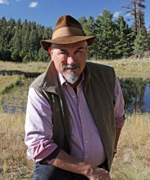 —Alan Dulaney
—Alan Dulaney
The August modeling runs are now out from the Bureau of Reclamation, along with revisions to the probabilities of declared shortage on the Colorado River. No surprises — things look worse than they did in April. The probability of Lake Mead water level elevations dropping below 1075 feet on January 1, 2020 — the trigger for a Tier 1 shortage — is now pegged at 57%. There just isn’t much time left to complete the Lower Basin Drought Contingency Plan (LBDCP) and stabilize the lake before much deeper cuts are triggered.
The LBDCP Steering Committee, chaired by ADWR and CAWCD, is facing four major issues in order to achieve a consensus that will pave the way for the Legislature to grant authority to the ADWR Director to sign on to the LBDCP. Recall that under LBDCP, Arizona will feel harsher cuts more quickly, and agriculture will be hit first and hardest. The first issue then is how to provide water sufficient to allow Pinal County agriculture to avoid an abrupt and devastating loss of all irrigation under LBDCP guidelines. Pinal County irrigation farmers would like all of the water loss to be mitigated, resulting in no change in demand. Many interests have supported this idea of full mitigation.
Solutions have been identified. CAWCD has about 200,000 acre-feet of storage space in Lake Pleasant, and will send 50,000 acre-feet of water to Pinal County to mitigate the impacts of shortage. Another method would be voluntary reductions in high-priority water use (by cities and tribes) with a genuine history of use. This latter term may be defined as excluding recharge activities, which the Cities will not accept. Additional methods include forbearance activities for compensation, imported groundwater, short-term leasing of high priority water, and well development. All of this will cost someone money and water. The use of existing CAWCD Intentionally Created Surplus on Lake Mead has been suggested — but how is moving water off Lake Mead supposed to leave water on Lake Mead to stabilize water levels?
And with Arizona eyes fixed firmly on Colorado River supplies, New Mexico chooses now as the time to pick up the pace on its plan to divert water from the Upper Gila River. In 2004, New Mexico was granted 14,000 acre-feet of Gila River water as part of the Arizona Water Settlement Act. It elected to build a series of diversion structures to irrigate farmlands. New Mexico dithered and now only has until 2019 to complete the Environmental Impact Statement and receive a favorable Record of Decision from Interior, or lose funding. A scoping document with public comments was to be completed in August, followed by a draft EIS in January 2019. It is hoped that the final EIS will be delivered in the summer of 2019, with the ROD slightly later. To me, this schedule seems overly optimistic, but that is the plan.
The 14,000 acre-feet of Gila River water would normally flow into Arizona. In recognition of the loss of this water, downstream parties in Arizona could take 14,000 acre-feet off the CAP canal as compensation. This seemed distant in 2004, but looks fairly imminent now. It is a demand seemingly not planned for in the LBDCP. Mostly these paper water deals do not address demand.
The insistent request for full mitigation by Pinal County agriculture is symptomatic of the way several interests on the Steering Committee feel about the LBDCP. The concept, not articulated but apparently underlying positions of many interests, appears to be that LBDCP will solve all problems, and life will go on as before with no change in demand and no real shortages for anyone. But where is the water going to come from for all these deals? There is only so much, and that volume will be reduced under LBDCP.
The truth is that LBDCP will result in less water coming down the CAP canal in order to stabilize Lake Mead water level elevations and prevent ever more damaging cuts. ADWR and CAWCD totally understand this. Moving paper water around does not change the fact that demands will not be satisfied and life will not be the same. Stabilization is not the same as stasis. Demand must be reduced somewhere, substantially, soon.
The Federal government can print money to address a deficit situation, but not so for the structural deficit on the Colorado River. You can’t print water. And you can’t spend what you don’t have. The Steering Committee must face that unpleasant fact, or fail.